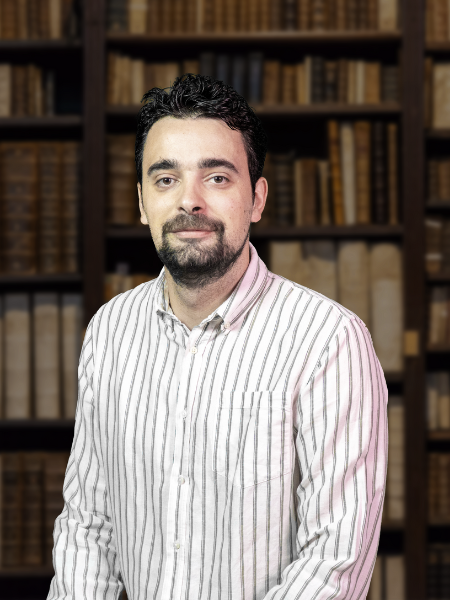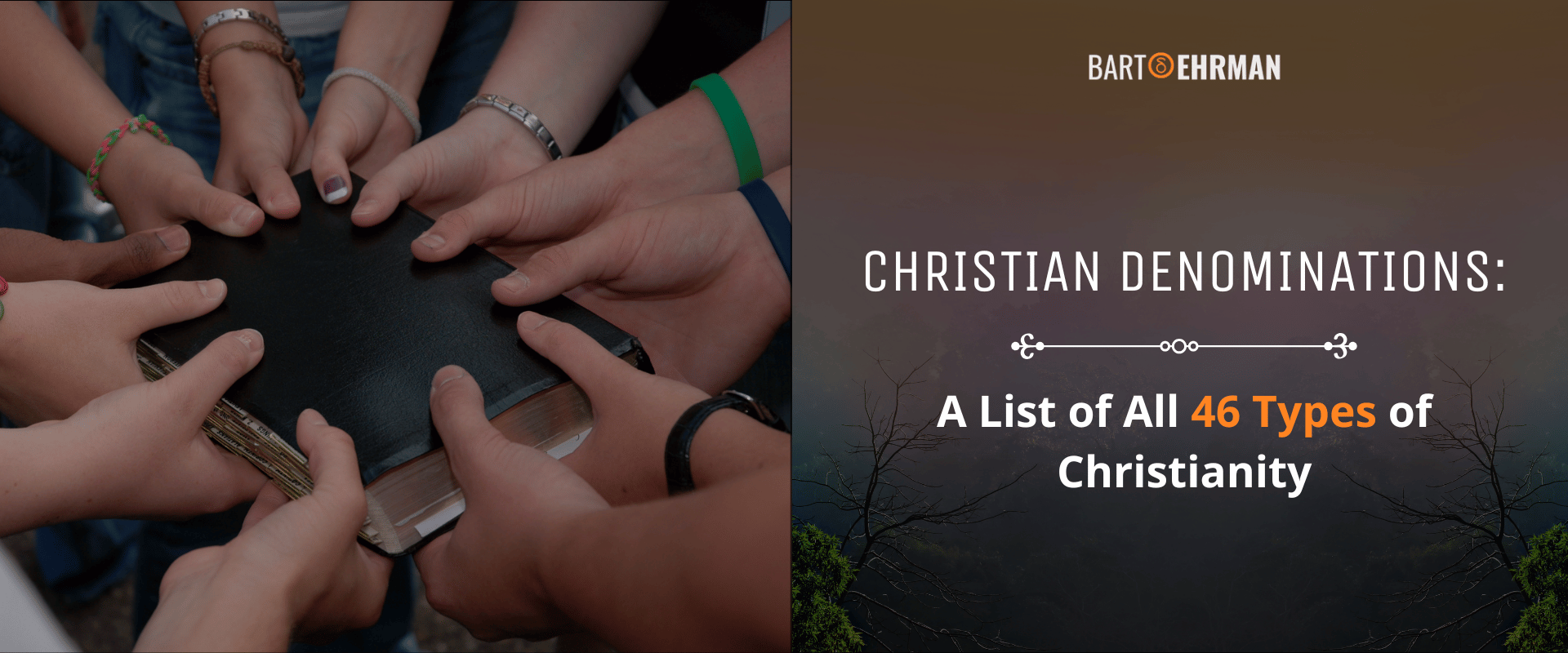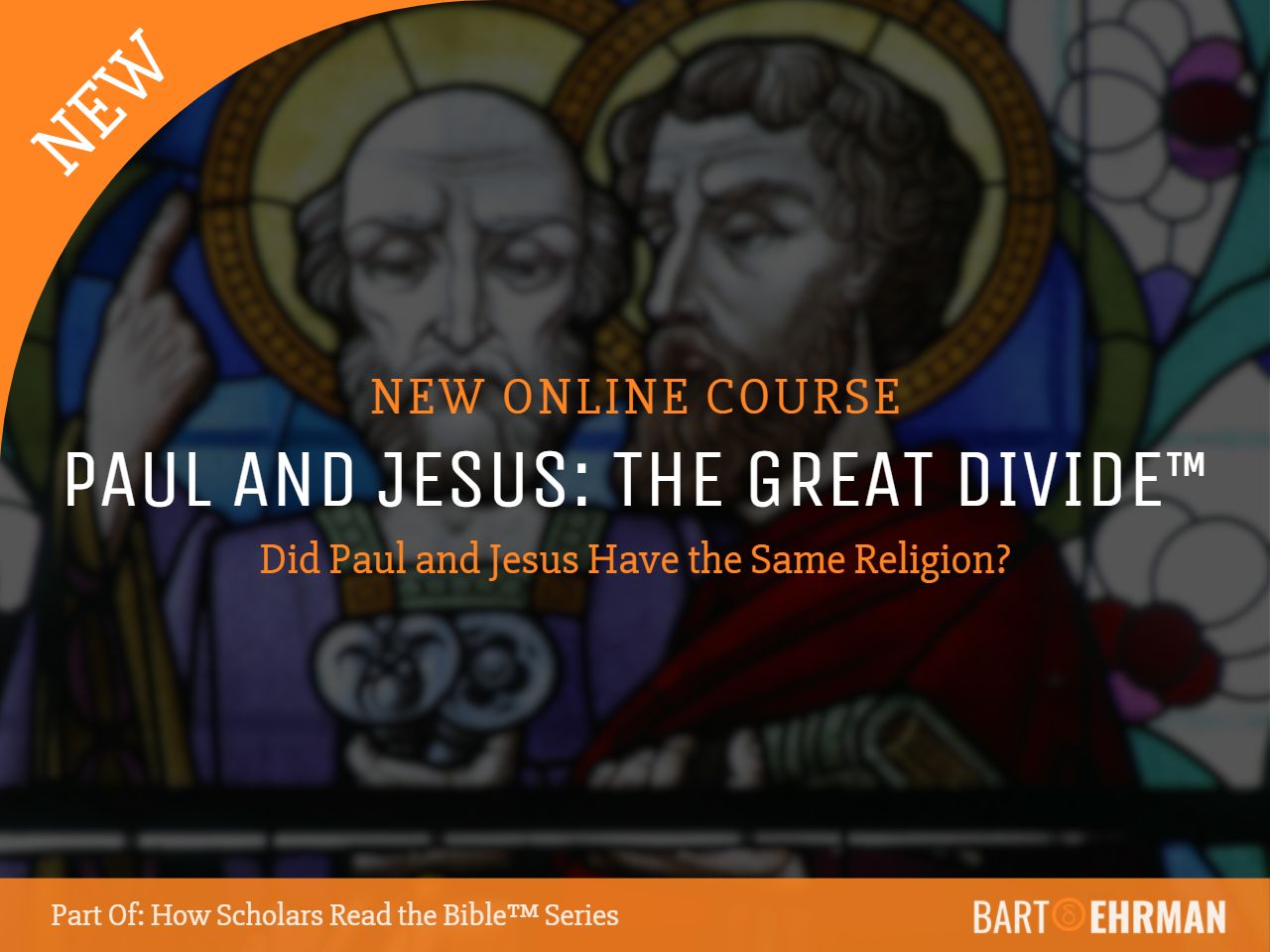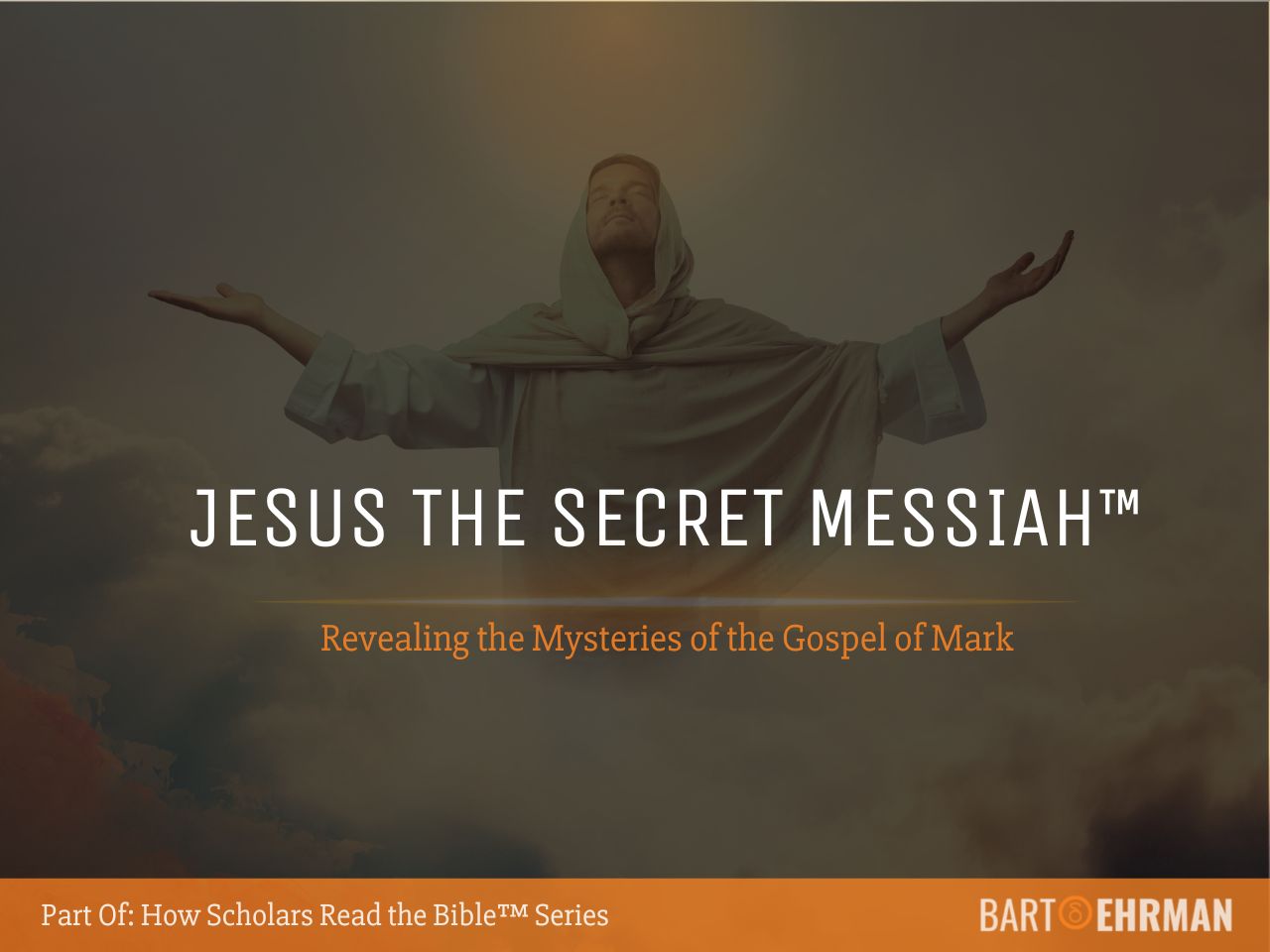Christian Denominations: A List of All 46 Types of Christianity

Written by Marko Marina, Ph.D.
Author | Historian
Author | Historian | BE Contributor
Verified! See our guidelines
Verified! See our editorial guidelines
Date written: December 12th, 2024
Edited by Laura Robinson, Ph.D.
Disclaimer: The views and opinions expressed in this article belong to the author and do not necessarily match my own. - Dr. Bart D. Ehrman
Recently, I noticed an advertisement for a lecture by a young Croatian theologian titled “What Kind of God Do Croats Believe In?”
At first, the title struck me as a bit unsettling, hinting at a close alignment between national identity and Christianity. As someone who appreciates the universalistic nature of Christianity — reflected in Paul’s assertion that “There is neither Jew nor Gentile, neither slave nor free, nor is there male and female, for you are all one in Christ Jesus” — I found the title limiting.
Christianity was built on the principle of inclusivity, intended to transcend borders, ethnicities, and social divides. But as I thought more about the topic, it became clear that this question touches on something more sociologically nuanced: Even within predominantly Catholic Croatia, there exists a rich diversity of Christian denominations.
Each of these has, in some way, influenced the cultural and historical fabric of our region. In this sense, perhaps the title speaks to a deeper complexity, even if unintended by the lecturer.
In this article, we’ll explore a list of 46 Christian denominations, examining the major branches and the prominent sub-branches within each. These “types of Christianity” aren’t simply isolated traditions but rather interconnected groups that reflect the dynamic evolution of Christian thought and practice.
While our earlier article covers a deeper examination of each branch of Christianity (including different sub-branches), this article provides a general survey of the most important Christian denominations.
Before diving into our exploration of the different types of Christianity, I highly recommend Bart D. Ehrman’s excellent online course, “Paul and Jesus: The Great Divide.. In this 8-lecture series, Dr. Ehrman offers a scholarly analysis of these two foundational figures in Christian history. Was Paul truly a disciple of Jesus? Would Jesus have embraced Paul’s teachings? Dive into Bart’s course to uncover the answers!

What Are Christian Denominations?
Christianity began humbly as a minor sect within Judaism in the 1st century. At its inception, it offered little indication that it would one day become the most widespread and diverse religion in the world. For the first three centuries, it was largely a community under the radar, practicing in relative obscurity and without any state support.
Yet, over two millennia, Christianity has grown, transformed, and spread into every land and language, becoming the largest and most universal of the world’s religions.
One striking feature of Christianity’s history is the abundance of disagreement that accompanied its expansion, which led to the formation of various Christian denominations. As historians Mary J. Weaver and David Brakke observe in their Introduction to Christianity:
(Affiliate Disclaimer: We may earn commissions on products you purchase through this page at no additional cost to you. Thank you for supporting our site!)
Christians differ substantially in doctrine, practice, and ecclesiastical structures, and those differences all arose within specific historical contexts. The more serious arguments among Christians led to major divisions within Christianity itself and the formation of separate churches and denominations... The fact that the early Christians had to figure things out rather than follow some predisposed plan of action is not a negative judgment but is a testament to the complicated realities of community life.
Similarly, Paula Fredriksen observes that the wide range of interpretations in late 1st-century Christianity was a natural consequence of the movement’s success.
Despite facing early setbacks and unfulfilled expectations, Christianity adapted and expanded beyond the initial message of an imminent end. Almost instinctively, the early Church updated its teachings, reshaping its traditions about Jesus to remain relevant and meaningful to each new generation.
It’s from this adaptive nature of “mischievous superstition” (to borrow Tacitus’ infamous words) that different Christian denominations emerged, each one preserving elements of the tradition while interpreting and reinterpreting them for changing times and contexts.
So, how many denominations of Christianity are there? The answer might surprise you! While exact numbers vary, some estimates suggest there are more than 45,000 distinct Christian denominations worldwide.
A “denomination,” as defined by Merriam-Webster, is “a religious organization whose congregations are united in their adherence to its beliefs and practices.” Given the range of beliefs and worship styles within Christianity, it’s no wonder that so many distinct denominations exist.
In contrast, a non-denominational church isn’t formally related to any established Christian denomination. Furthermore, it often emphasizes individual interpretation of Scripture and a more flexible approach to worship and liturgy.
This independent nature of the non-denominational church opens space for a wide variety of beliefs and practices (focused, of course, on Jesus) which further contributes to the diversity within modern Christianity.
Finally, while it’s impossible to cover all 45,000 Christian denominations in a single blog post, we can highlight some of the most impactful groups that have shaped the Christian tradition and Western civilization. These denominations are grouped within the major branches of Christianity, each representing a rich tradition of faith, practice, and historical significance. Let’s take a look!
List of 46 Christian Denominations
#1 – Catholic Church
#1.1 – Roman Catholic Church
#1.2 – Eastern Catholic Churches
#1.2 (a) – Maronite Catholic Church
#1.2 (b) – Melkite Greek Catholic Church
#1.2 (c) – Ukrainian Greek Catholic Church
#1.2 (d) – Syro-Malabar Catholic Church
#2 – Eastern Orthodoxy
#2 (a) – Greek Orthodox Church
#2 (b) – Russian Orthodox Church
#2 (c) – Serbian Orthodox Church
#2 (d) – Bulgarian Orthodox Church
#2 (e) – Romanian Orthodox Church
#2 (f) – Georgian Orthodox Church
#2 (g) – Antiochian Orthodox Church
#2 (h) Orthodox Church in America
#3 – Protestantism
#3.1 – Lutheranism
#3.1 (a) – Evangelical Lutheran Church in America
#3.1 (b) – Lutheran Church-Missouri Synod
#3.1 (c) – Wisconsin Evangelical Lutheran Synod
#3.2 – Calvinism
#3.2 (a) – Presbyterian Church
# 3.2 (b) – Reformed Church in America
#3.2 (c) – Christian Reformed Church
#3.3 – Anglicanism
#3.3 (a) – Church of England
#3.3 (b) – Episcopal Church (U.S.)
#3.3 (c) – Anglican Church in North America
#3.4 – Baptists
#3.4 (a) – Southern Baptist Convention
#3.4 (b) – American Baptist Churches U.S.A.
#3.4 (c) – National Baptist Convention
#3.5 – Methodism
#3.5 (a) – United Methodist Church
#3.5 (b) – African Methodist Episcopal Church
#3.5 (c) – Free Methodist Church
#3.6 – Pentecostalism
#3.6 (a) – Assemblies of God
#3.6 (b) – Church of God
#3.6 (c) – United Pentecostal Church International
#3.6 (d) – International Church of the Foursquare Gospel
#3.7 – Other Notable Protestant Movements
#3.7 (a) – Anabaptists
#3.8 – Restorationists
#3.8 (a) – Churches of Christ
#3.8 (b) – Disciples of Christ
#3.8 (c) – Christian Church
#3.8 (d) – Adventists
#3.8 (e) – Quakers
#4 – Oriental Orthodoxy
#4.1 – Coptic Orthodox Church
#4.2 – Armenian Orthodox Church
#4.3 – Ethiopian Orthodox Church
#4.4 – Syriac Orthodox Church
#4.5 – Malankara Orthodox Syrian Church
#5 - Assyrian Church of the East
#5.1 – Assyrian Church of the East
#5.2 – Ancient Church of the East
#5.3 – Chaldean Syrian Church
Roman Catholicism
Roman Catholicism is the world's largest Christian denomination with more than 1 billion members!
The Catholic Church traditionally claims St. Peter as its first bishop, asserting an unbroken line of leadership from the apostles to the present. However, historians today observe that Roman Catholicism gradually took shape over several centuries, particularly in the 4th and 5th centuries.
This period saw the rise of the papal office and the formalization of many doctrines that continue to define the Church. Key theological disputes about the nature of Christ, the Trinity, and the relationship between Christ’s divinity and humanity were addressed through four influential ecumenical councils between 325 (Nicaea) and 451 C.E. (Chalcedon).
These councils were instrumental in defining Christian “orthodoxy,” and their conclusions continue to be accepted by the majority of Christians, including Roman Catholics.
A defining characteristic of Roman Catholicism is its hierarchical structure, with the Pope as the supreme spiritual authority. The papacy, which developed significantly during the early centuries, is seen by Catholics as the continuation of Peter’s role, with each pope viewed as his successor.
As the ”The Catechism of the Catholic Church” explains: “The Church is apostolic. She is built on a lasting foundation: 'the twelve apostles of the Lamb.' She is indestructible (cf Mt 16:18). She is upheld infallibly in the truth: Christ governs her through Peter and the other apostles, who are present in their successors, the Pope and the college of bishops.”
This belief in papal primacy is central to Catholic identity, setting it apart from other Christian denominations that may respect but do not formally acknowledge the Pope’s authority.
Distinctive practices also mark Roman Catholicism. The seven sacraments (baptism, confirmation, Eucharist, penance, anointing of the sick, holy orders, and matrimony) are central to Catholic worship and theology.
These sacraments are seen as means of receiving God’s grace and play a vital role in the spiritual life of Catholics, from birth to death. In his highly influential book Introduction to Christianity, Joseph Ratzinger (Pope Benedict XVI) notes:
The Christian notion of man, the problem of sin and redemption, are echoed in them once again, but their chief function is to affirm the sacramental idea which for its part forms the heart of the concept of the Church: Church and sacrament stand or fall together; a Church without sacraments would be an empty organization, and sacraments without a Church would be rites without meaning or inner connection.
Catholicism also places significant emphasis on Tradition alongside Scripture. Unlike some other Christian denominations, which rely solely on the Bible, the Catholic Church upholds both Scripture and Tradition as sources of authority.
Richard P. McBrien explains the Catholic view on Scripture and Tradition:
The Scripture is itself a product of Tradition. It’s not as if you first have Scripture and then you have Tradition (which is, among other things, the Church’s subsequent reflection on Scripture). Tradition comes before and during, and not just after, the writing of Sacred Scripture.
Globally, Roman Catholicism has played an unparalleled role in shaping Western civilization and continues to have a significant presence on every continent. From education to social services, its institutions have been and continue to be of paramount importance!
Eastern Orthodoxy
In the 11th century, relations between Christianity in the East and West were severed — a divide that remains to this day. This schism between the two earliest forms of Christianity has persisted for more than a thousand years. While the symbolic date of the split is 1054, like many separations, it was the result of centuries of growing estrangement.
And, much like other “divorces,” it was a painful experience, representing one of the more sobering chapters in Christianity’s history.
As Tim Dowley notes in A Brief Introduction to Christianity:
The major disruptions within the Roman Empire in the fifth century led to a growing rift between the Western and Eastern churches. Increasing tension over political [different views on the relationship between the Church and the state; disagreements about the role of the pope, etc.] as much as theological [the infamous filioque controversy] issues led to the ‘Great Schism’ of 1054.
Unlike Roman Catholicism, Eastern Orthodoxy doesn’t accept the Pope’s authority. Instead, it views him as one bishop among equals rather than a supreme authority over the entire Church. However, as Timothy Ware argues:
Orthodoxy is not just a kind of Roman Catholicism without the Pope, but something quite distinct from any religious system in the West. Yet those who look more closely at this ‘unknown world’ will discover much in it which, while different, is yet curiously familiar.
Central to the Eastern Orthodox faith is the liturgy, a rich, sensory experience that immerses worshippers in a sacred space of prayer, chant, and ritual. The Divine Liturgy, especially the Liturgy of St. John Chrysostom, is the focal point of Orthodox worship, emphasizing communal prayer and a sense of divine mystery.
Did You Know?
Hesychasm: The Quiet Path to Divine Connection
The term comes from the Greek word for “quiet,” and this contemplative prayer technique is all about letting go of the mind’s noise to enter into a profound, peaceful silence. Hesychasm has been passed down for centuries through monastic tradition and remains a key part of Orthodox spirituality today, especially in places such as Mount Athos in Greece!
And here’s an interesting twist: hesychasm draws from the writings of an otherwise mysterious figure, Dionysius the Areopagite (c. 480-550 C.E.), who described the ultimate experience of God as a “dark cloud” that goes beyond understanding.
According to Dionysius, Jesus, the “God-man,” connects all of creation in a “great chain of being.” Through practices like hesychasm, Orthodox monks seek theosis — a kind of “divinization” that prepares them for a glimpse of God’s glory. The concept sounds complex, but at its heart, it’s all about experiencing a deeper, nonrational connection with the divine!
Furthermore, icons play an especially significant role in Orthodox spirituality. Orthodox believers venerate icons not as idols but as a means of communicating with the saints and with Christ, who are depicted in these holy images.
The use of icons is rooted in the theology of the Incarnation. By becoming human, Eastern Orthodox theologians argue, Christ sanctified material creation, making it a worthy vessel for divine representation.
Orthodoxy also emphasizes the sacraments, known as “holy mysteries,” as essential means through which believers receive God’s grace. Ware explains: “Church and sacraments are the means appointed by God whereby we may acquire the sanctifying Spirit and be transformed into the divine likeness.”
Geographically, Eastern Orthodoxy, as one of the Christian denominations, remains prominent in Eastern Europe, Russia, and parts of the Middle East, where it has had a deep cultural influence. From the Byzantine Empire to the Ottoman occupation, Orthodoxy has preserved its theological and liturgical traditions despite centuries of political changes and challenges.
As we continue exploring the major types of Christianity, our focus now shifts to Protestantism.
While some Eastern Orthodox theologians might classify Protestantism as one of the “sects of Christianity,” its impact and historical significance (particularly in shaping Western Christian thought and culture) is undeniable. Protestant tradition stands as a distinct and influential force within the broader Christian landscape.

Protestantism
The roots of Protestantism lie in a fascinating interplay of crisis and vitality within the Catholic Church at the end of the 15th century. As John van Engen notes in his insightful study, the Church on the eve of the Reformation displayed seemingly contradictory features: Widespread corruption alongside vigorous renewal.
On the one hand, frustrations over clerical abuses — anticlerical sentiment, the buying and selling of church offices (simony), and the morally questionable lifestyles of some clergy — fueled discontent. A prime example of such decadence is Pope Alexander VI (r. 1492–1503), infamous for his nepotism, lavish lifestyle, and numerous scandals, including fathering several children while in office.
At the same time, however, there were unmistakable signs of spiritual vitality: Fervent lay piety, grassroots reform movements, and a flourishing culture of personal piety. The late medieval laity, for example, invested massively in religion by paying for churches and their upkeep, donating masses, and financing urban preachers!
This paradoxical mix of corruption and reform created fertile ground for the emergence of Protestantism. Not born of religious apathy, the Reformation, von Engen argues, arose from a climate of intense religiosity and widespread concern for the Church’s future.
Into this charged atmosphere stepped Martin Luther, an Augustinian monk whose theological insights and bold actions would ignite the Reformation. The spark came in 1517, when Luther nailed his 95 Theses to the church door in Wittenberg, challenging the sale of indulgences.
At the Leipzig Disputation in June 1519, Luther took a revolutionary step, declaring that scripture alone (sola scriptura), not popes or councils, held ultimate authority for Christians. This assertion, while essentially theological, had profound institutional implications, undermining the Church's hierarchy.
Luther's defiance reached a fever pitch in 1520 when the pope threatened him with excommunication. Instead of backing down, Luther doubled down by publishing three landmark treatises:
Address to the Christian Nobility of the German Nation, which called for secular leaders to reform the Church; The Babylonian Captivity of the Church, which attacked the sacramental system; and The Freedom of a Christian, which articulated his belief in justification by faith alone (“sola fide”).
When summoned to recant his views at the Diet of Worms in April 1521, Luther famously refused, declaring: “Here I stand, I can do no other.”
Condemned as a heretic by Charles V and declared an outlaw, Luther went into hiding but continued his work, translating the Bible into German and building the foundations of the Protestant movement.
At its core, Protestantism introduced key theological principles that distinguished it from Roman Catholicism. Chief among these was the concept of “sola scriptura,” the idea that the Bible is the sole authority in matters of faith and practice.
Additionally, “sola fide,” the belief that salvation comes by faith alone and not by works, struck at the heart of Catholic sacramental theology. Protestants also rejected the Catholic doctrine of transubstantiation (a belief that the substance of bread and wine is changed by God’s power into the substance of Christ’s body and his blood during communion).
Protestantism, however, was far from monolithic. From the Lutheran churches in Germany to the Calvinist Reformed traditions in Switzerland and the Anglican Church in England, the movement fragmented into numerous branches, each with its emphasis on theology, governance, and worship.
This diversity has continued to expand over centuries. A glimpse into the Pew Research Center’s survey reveals thousands of different Christian denominations (including non-denominational churches) — a reality that Martin Luther probably couldn’t even imagine!
This makes Protestantism one of the most dynamic and varied types of Christianity in the world today. Its emphasis on personal faith, scripture, and reform has left an indelible mark on Christian history, as well as on the development of Western society and culture.
Oriental Orthodoxy
Complex Christological controversies of the early 5th century are the place to look for the emergence of Oriental Orthodoxy as one of the major Christian denominations.
As it turns out, the pivotal moment came at the Council of Chalcedon in 451 CE, where a majority of the Church adopted the Chalcedonian Definition which argues that Christ exists in two natures, divine and human, united in one person.
However, “as with the Creed of Nicaea one hundred and twenty-five years before,” Leo D. Davis notes, “the definition of Chalcedon was not the end but the intensification of controversy.”
The Oriental Orthodox Churches, for instance, rejected this formulation, adhering instead to miaphysitism. This theological position holds that Christ's divinity and humanity are united in one nature without confusion, without change, without division, and without separation.
This distinction led to what Timothy Ware labels as the “first stage in the separation” within the main body of Christians living in what was, back then, the eastern part of the Roman Empire.
Furthermore, events of the 5th century carried political and cultural associations. The Oriental Orthodox Churches often existed in regions on the periphery of the Byzantine Empire, such as Egypt, Armenia, Ethiopia, and Syria, where local populations resisted Byzantine dominance.
The liturgical practices of Oriental Orthodoxy are very characteristic and reflect a rich mixture of ancient Christian traditions and local cultural expressions. The liturgies are often characterized by elaborate and symbolic rituals, long prayers and the use of ancient liturgical languages, such as Ge'ez in the Ethiopian Orthodox Church.
The Oriental Orthodox Churches also emphasize the sacramental life, with a particular focus on the Eucharist, which is regarded as the real presence of Christ. Additionally, the veneration of saints and the use of iconography, though less pronounced than in Eastern Orthodoxy, remain important elements of their devotional practices.
The Assyrian Church of the East
As we approach the end of our journey into the world of Christian denominations, we turn to the Assyrian Church of the East — a tradition with ancient roots and a remarkable story. Emerging from the early Christian communities of the East, the Church claims its origins from the apostolic age and the legendary account of St. Thomas' missionary work in the East.
By the 4th century, this community had established itself in Mesopotamia, far from the political and theological epicenters of Rome and Constantinople. For instance, the Church of the East was well established in the Persian capital, Seleucia-Ctesiphon.
However, this process was by no means easy. As Christine Chaillot explains in her book The Assyrian Church of the East: History and Geography:
In Persia, the state’s official religion was Zoroastrianism. This situation led to the widespread religious persecution of Christians (bishops, priests, deacons, and laypeople) in Persia from 338 to 363, then more sporadically until 379. These persecutions were driven, at least in part, by distrust of the loyalty of Persian Christians vis-à-vis ‘Western Christianity,’ that is to say, the Christianity of the Byzantine Empire, and so fear of potential treason to the benefit of the enemy power.
Nevertheless, the Church survived and, over time, became known as the “Church of the East,” shaped by its distinct cultural and historical context.
Theologically, the Assyrian Church of the East is best known for its adherence to dyophysitism, the belief that Christ’s divine and human natures are distinct yet united in one person.
While this type of Christianity maintains that these natures are united in one person, its Christology has been perceived as attributing greater independence to Christ’s human and divine aspects. This led to criticisms from Chalcedonian Christians, who interpreted it as a separation of the two natures into two persons, though this isn’t the Church’s official teaching.
Furthermore, the Assyrian Church of the East famously rejected the Council of Ephesus (431 C.E.), though not primarily due to doctrinal disagreements. Instead, the Church objected to the procedural irregularities surrounding the council, particularly the hurried manner in which decisions were made and the lack of representation from key theological voices of the East.
Despite these procedural concerns, the Church’s rejection of Ephesus has historically been misinterpreted by subsequent generations, leading to its characterization as “Nestorian.” This label emerged from the association of the Church with the teachings of Nestorius, a theologian condemned at Ephesus for his views on the relationship between Christ’s divine and human natures.
However, contemporary scholarship has revealed this misinterpretation. As Sebastian P. Brock notes in his article:
The association between the Church of the East and Nestorius is of a very tenuous nature, and to continue to call that church 'Nestorian' is, from a historical point of view, totally misleading and incorrect — quite apart from being highly offensive and a breach of ecumenical good manners.
Liturgy in the Assyrian Church of the East is a defining feature of its identity. The Church uses Syriac, a dialect of Aramaic, as its liturgical language, connecting its worshippers to the language spoken during the time of Christ.
Today, the Assyrian Church of the East has a relatively small but dedicated following, with communities in the Middle East, India, and a growing diaspora in the Americas, Europe, and Australia.
Despite centuries of persecution, including significant challenges in modern times, the Church has remained steadfast in preserving its unique theological and liturgical traditions.
Conclusion
Reflecting on the question posed by the Croatian theologian I mentioned in the introduction (“What Kind of God Do Croats Believe In?”), it becomes clear that the answer can’t be confined to a single narrative or perspective — not even in Croatia where most of the people identify as Roman Catholics!
As this exploration of Christian denominations has shown, Christianity itself is a tapestry of traditions, shaped by centuries of theological debate, cultural diversity, and historical challenges.
From the towering structure of Roman Catholicism, with its papal authority and sacramental life, to the mysticism and liturgical beauty of Eastern Orthodoxy, the theological precision of Oriental Orthodoxy, the reforming zeal of Protestantism, and the steadfast perseverance of the Assyrian Church of the East, each type of Christianity offers a unique window into the enduring adaptability and universality of this religion.
And what about the lecture by the young Croatian theologian? Well, I won’t be able to attend, but I remain both intrigued and skeptical about its outcome. The title raises questions that paradoxically seem at once compelling and limiting.


